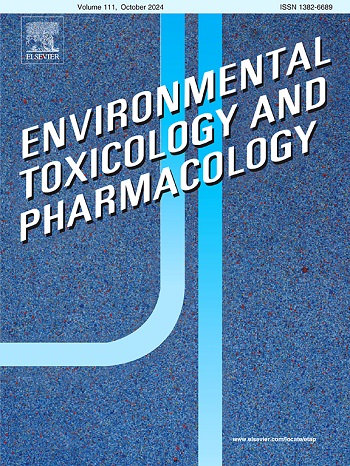具有代表性的城市稀土混合元素对虹鳟鱼幼鱼的生态毒性
IF 4.2
3区 环境科学与生态学
Q2 ENVIRONMENTAL SCIENCES
引用次数: 0
摘要
城市污水中含有一种特殊的稀土元素(ree)混合物,其中以钆(Gd)为主。研究了虹鳟鱼暴露于由Gd(105 ng/L)、Ce(9 ng/L)、Nd(8 ng/L)、Yb(6.2 ng/L)和Dy(4 ng/L)组成的代表性稀土混合物(城市废水)的亚致死和致死毒性,这些稀土混合物对应于137 ng/L的总稀土负荷。在15 °C下,将幼鱼暴露于浓度在0.5到100倍之间的稀土混合物中(Gd占负载的80% %)96 h。数据显示,100X混合物不是急性致死的,但在浓度在1-10X范围内产生一系列亚致死效应,这可以在一些城市废水中发现。亚致死效应包括肝脏重量、热稳定金属结合蛋白、蛋白质聚集、脂质过氧化和DNA损伤的变化。因此,在环境相关浓度的幼鱼中观察到这些亚致死效应。这表明,在废水中发现的稀土元素可能对鱼类种群造成长期的负面影响。本文章由计算机程序翻译,如有差异,请以英文原文为准。
Ecotoxicity of a representative urban mixture of rare earth elements to rainbow trout juveniles
Municipal wastewaters contain a peculiar mix of rare earth elements (REEs) dominated by gadolinium (Gd). The sublethal and lethal toxicity was examined in rainbow trout exposed to a representative REE mixture (municipal waswaters) composed of Gd (105 ng/L), Ce (9 ng/L), Nd (8 ng/L), Yb (6.2 ng/L) and Dy (4 ng/L) corresponding to total REEs loading of 137 ng/L. Juveniles were exposed to a mixture of REEs (Gd representing 80 % of the loading) at concentrations between 0.5 and 100X for 96 h at 15 °C. The data revealed that the 100X mixture was not acutely lethal but produced a range of sublethal effects at concentrations in the 1–10X range, which could be found in some municipal wastewaters. The sublethal effects involved changes in liver weight, heat stable metal binding proteins, protein aggregation, lipid peroxidation and DNA damage. Hence, these sublethal effects were observed in juvenile fish at environmentally relevant concentrations. This suggests that the REEs found in wastewaters could contribute to long-term negative impacts on fish populations.
求助全文
通过发布文献求助,成功后即可免费获取论文全文。
去求助
来源期刊
CiteScore
7.00
自引率
4.70%
发文量
185
审稿时长
34 days
期刊介绍:
Environmental Toxicology and Pharmacology publishes the results of studies concerning toxic and pharmacological effects of (human and veterinary) drugs and of environmental contaminants in animals and man.
Areas of special interest are: molecular mechanisms of toxicity, biotransformation and toxicokinetics (including toxicokinetic modelling), molecular, biochemical and physiological mechanisms explaining differences in sensitivity between species and individuals, the characterisation of pathophysiological models and mechanisms involved in the development of effects and the identification of biological markers that can be used to study exposure and effects in man and animals.
In addition to full length papers, short communications, full-length reviews and mini-reviews, Environmental Toxicology and Pharmacology will publish in depth assessments of special problem areas. The latter publications may exceed the length of a full length paper three to fourfold. A basic requirement is that the assessments are made under the auspices of international groups of leading experts in the fields concerned. The information examined may either consist of data that were already published, or of new data that were obtained within the framework of collaborative research programmes. Provision is also made for the acceptance of minireviews on (classes of) compounds, toxicities or mechanisms, debating recent advances in rapidly developing fields that fall within the scope of the journal.

 求助内容:
求助内容: 应助结果提醒方式:
应助结果提醒方式:


